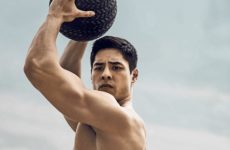The contemporary fitness scene is a minefield of misinformation, shams and false promises. We are bombarded with advertisements that sell exercise at any cost and usually feature some polished-up thing that’s been around forever with a new name slapped on it or device to accompany it. The time crunch of modern life leaves no room for experimenting with dubious, poorly thought out routines filled with gimmicks that offer subpar results at best. Today’s men need time-tested methods that are safe, effective and allow them to do everything else in life that they desire with energy and without pain. That’s where Pilates comes in.
True, some people think of it as a 90s fad that came and went, but those people haven’t been paying attention. Nearly a century old, Pilates is still around for a reason. Not only is it a truly brutal strength workout when practiced under the hands of an experienced teacher, it produces balanced musculature, an impossibly strong core and a supple body with full range of motion. As such, it’s seen a huge resurgence thanks to professional athletes like Jake Arrieta of last year’s World Series winning Chicago Cubs who credits Pilates with radically improving his game, not to mention physique, and keeping him uninjured. But he’s not alone. Andy Murray, the top-ranked British tennis player, Wimbledon winner and Olympic gold medalist also saw huge improvements to his game after starting a traditional Pilates regime.
But what is Pilates exactly? Where can people find the best Pilates? If people are already active, how specifically can it benefit them? What kinds of Pilates are out there? How does Pilates help men enjoy all the other activities they participate in? To answer these questions and many more, we turned to fully certified, New York City-based Pilates teacher Katie Yip. In addition to being a rising member in the Pilates profession, she holds a bachelor’s degree in physiology and neuroscience from the University of California, San Diego, a master’s degree in exercise physiology from Columbia University and was a finalist in the Women’s Health Next Fitness Star challenge. Enjoy our conversation with her below. To learn more about Katie, visit her website at katieyippilates.com.
Pilates has been around a long time and people know the word, but usually think it’s something similar to yoga. What is Pilates and how was it created?
Pilates, originally referred to as Contrology, is the synchrony of body, mind, and spirit for the purpose of acquiring complete control over one’s own body. The Pilates method was created by Joseph Pilates over a lifetime of studying human anatomy and animal movements as a means to rectify his own physical ailments. Through his system people could ‘gain the mastery of their mind over the complete control of their bodies’. Joseph Pilates’ philosophies are stated in his book Return to Life through Contrology with which he calls for empowerment through physical health and independence.
How did you get started in Pilates and who are your teachers?
My interest in fitness started when I was a kid. I was always involved in some sort of physical activity from soccer to martial arts. While in college, I pursued my interest in exercise and the human body by majoring in physiology and neuroscience while concurrently working at an exercise physiology laboratory studying metabolism. After college, I had a brief stint in the biotechnology industry, but realized it was not for me and decided to devote myself to my Pilates training. From that point onwards, I went on to study the Method under the guidance of Chris Robinson of S6 Fitness, earn a graduate degree in Exercise Physiology from Columbia University, and complete a formal apprenticeship with Brooke Siler of Re:AB Pilates. I continue my studies under the tutelage of Kathi Ross-Nash of American Body Tech and am set to matriculate in the studio’s Pilates Professional Advanced Teacher Training in 2018.
There are many kinds of Pilates or Pilates-infused workouts flooding the market. What kind of Pilates do you teach and how does it differ from everything else?
I focus on authentic Pilates – the original style of Pilates that remains as close as possible to Joseph Pilates’ method regarding the apparatus, exercises, and intent. Unfortunately, the Method has been diluted down to reductionistic movements that no longer embody the essence of the original work.
Joseph Pilates created his method for men, but most people today associate his work with women and, often, dancers. How did this come to be and in what ways does Pilates address the physiological issues that are specific to men?
Most people associate the Method with dancers because the dance community was the most cohesive group of athletes to utilize and promote the Method. Famous dancers/choreographers such as George Balanchine and Martha Graham studied under Pilates and consequently sent their students to Pilates’ studio for training and rehabilitation. The success of dance students that came out of Pilates’ training program were a testament to the Method and they became pioneers by incorporating it into their fitness routines. Importantly, this is not to negate the other athletic groups that utilized the Pilates system, dancers were simply the most influential group. Pilates himself was a boxer, gymnast, martial artist and was sought out by skiers and boxers alike for training and rehabilitation.
The Pilates method is an excellent exercise discipline suited for all levels physical fitness. It acts as a great complement to the conditioning of any other sport as it is a system that improves upon functional fitness and foundational movement patterns. Specific to men, Pilates builds uniform strength and flexibility, with improved control and control of range of motion, which is critically important as men tend be far stiffer than women especially as they age.
You hold a Master’s degree in Exercise Physiology from Columbia University. Having studied the science of the body so closely, has your perspective on Pilates changed at all? Do you have any insights into the efficacy of the method that perhaps you didn’t before?
“As to methods, there may be a million and then some, but principles are few. The man who grasps principles can successfully select his own methods. The man who tries methods, ignoring principles, is sure to have trouble.” – Ralph Waldo Emerson
Movement is movement, and to reference the quote above, regardless of exercise modality the principles of exercise do not change. Through my university studies at both the graduate and undergraduate level, I have learned that Pilates is one of many effective methods for improving general fitness because it adheres to the tenets of movement and alignment.
Applying evidence-based practice has helped me understand why, and embrace how Pilates is an incredibly effective exercise program, and perhaps one superior to other methods of movement re-education. Research has shown that core stability is rooted in not only strength, but also the proper timing and activation of muscles before the actual intended movement occurs. These timing sequences are stored in the brain as movement patterns; storage of patterns is more efficient and reduces the brain’s processing time by categorizing single movements into groups of movements. Thus core stability is not only a product of pure strength of the muscles, but also timing sequences. These principles are evidenced in all of Joseph Pilates’ exercises. Thus I learned that it is incorrect to label Pilates as only a “core” workout. It is instead a vigorous full body workout that aims to strengthen and challenge the muscles the way they are designed and expected to function in real life.

Today, people seem to vacillate between being sedentary at a desk and very active in their free time where they pursue everything from running, Crossfit, swimming and cycling, which often leads to nagging aches and pains. How is Pilates a useful cross-training methodology and how can it assist with injury prevention?
Because Pilates is a solid foundation for fitness, coordination, and full range of movement, it acts as a great complement for the conditioning of any other sport.
Before beginning any skill intensive sports or activities, athletes, weekend-warriors, and anyone in pursuit of optimal health should understand how to move efficiently through basic movement patterns. This requires strength, joint stability, full physiological range of motion, motor control, balance, endurance, and, importantly, movement without pain. In an attempt to counteract the ubiquity of the modern day sedentary lifestyle, we engage in highly technical activities (e.g. Crossfit) without a foundation of basic fitness. Poor fitness cannot be solved with aggressive physical training, and building a set of intricate skills on dysfunction compromises performance and increases risk of injury. I have found that Pilates, when taught correctly, is one of the best platforms to create a solid foundation with which athletics and other modalities of exercise can be built upon.
Do you feel like the awareness of Pilates’ origins is becoming more well known today? Are different kinds of clients coming to the work for the first time than in years past?
The awareness of Pilates is becoming more well known today. I have the opportunity to work with clientele that run the gamut from teenagers to people in their 80s. A variety of people with diverse athletic backgrounds are coming to Pilates for the first time because it is the necessary foundation for movement. Although there are many methods that teach movement principles, Pilates is effective because of the way it utilizes a system, specifically the apparatus, to both strengthen and challenge the body.
If someone is brand new to Pilates and is searching for a teacher or a place where they could take lessons, what advice would have for them in terms of what qualifications to look for or things they should keep in mind?
In terms of qualifications, a ‘certified’ teacher should have gone through a minimum of 600 hours of seminars, observation, and supervised teaching. A ‘certificate’ is not a means to end, but a means to the beginning of committed study to the Method. Any program that deviates from this notion by accommodating weekend or month-long training produces ill-equipped teachers. Importantly, the Pilates method is a system — not just the mat, or just the reformer. A qualified teacher should understand this philosophy of Pilates and how to apply it to the individual client. Additionally, continuing education is essential to the committed study of the Method. Aside from certifications, word of mouth is one of the best ways to find a capable teacher. There are also directories through which Pilates teachers are properly vetted prior to having their names published, which can be found at pilatesology.com or classicalpilates.net.
Having studied Pilates with incredible teachers for several years, what are the biggest benefits you’ve seen and what excites you most about this form of exercise?
My body has completely changed under the mentorship of Kathi Ross-Nash. Through my studies, I have learned that Pilates is a system, not an exhaustive list of exercises. I am stronger, leaner, and I have control over my flexibility. My body is balanced in both strength and flexibility, and I understand what it means to embody a balance of both strength and flexibility with control. What continues to excite me about Pilates is that I learn something new every day – it never gets boring! I am constantly learning about my body and building awareness in parts that I never would have imagined.
written by martin lerma



